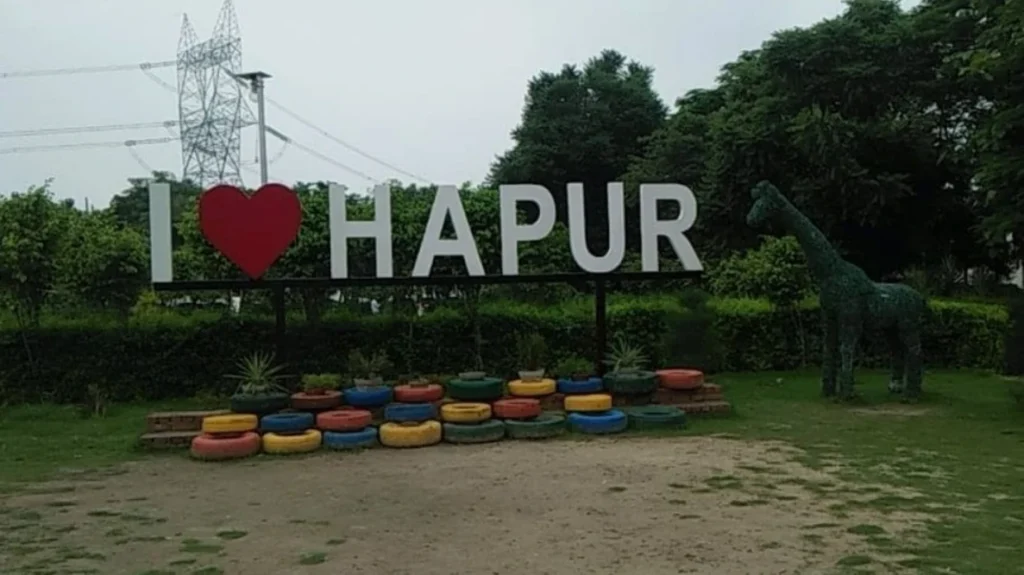Discover Hapur, Uttar Pradesh – a hub of heritage, industry, and culture. Explore its rich history, vibrant markets, and evolving urban landscape!

Explore Hapur Where History Progress & Tradition Meet
Nestled in the heart of Uttar Pradesh, India, Hapurr District is a tapestry of history, culture, and progress. Spanning an area of approximately 2,400 square kilometers, the district is characterized by its diverse landscapes, bustling towns, and a population that embraces tradition while forging ahead into modernity.
Historically, Hapur has been a crossroads of civilizations, witnessing the ebb and flow of cultures. Evidence of its ancient past can be found in the form of archaeological sites and artifacts, which reflect its connection to the Mauryan, Gupta, and Mughal periods. This rich historical backdrop has endowed the district with a unique identity that is cherished by its residents.
The district’s administrative hub, the city of Hapurr, is a microcosm of its eclectic essence. The bustling markets, adorned with traditional architecture, offer a vivid kaleidoscope of colors and aromas. The bazaars are teeming with a wide range of goods, from intricate handicrafts and textiles to local produce that reflects the region’s agricultural heritage. This fusion of old-world charm and modern commerce creates an atmosphere that appeals to both residents and visitors.
Agriculture remains a cornerstone of Hapur’s economy, with fertile plains supporting the cultivation of crops like wheat, sugarcane, and rice. The district’s proximity to the national capital, Delhi, has facilitated economic growth and urbanization, transforming towns like Pilkhuwa and Garhmukteshwar into thriving industrial and commercial centers. These towns are now home to small and medium-sized enterprises, contributing to the district’s economic vitality.
Hapur’s cultural fabric is woven with festivals and traditions that celebrate its diverse heritage. Religious festivals such as Diwali, Eid, and Holi are observed with great enthusiasm and communal harmony. The district’s social landscape is marked by a tapestry of languages, including Hindi, Urdu, and Punjabi, reflecting its multicultural populace.
Education and social development are also on the rise in Hapur. The establishment of schools and colleges has empowered the youth with knowledge and skills, opening doors to new opportunities. Furthermore, initiatives to improve healthcare facilities have resulted in better medical services, enhancing the quality of life for residents.
As Hapur District continues to stride toward progress, preserving its cultural identity remains a priority. Efforts to balance growth with heritage conservation are visible in restoration projects that protect historical sites and promote sustainable tourism. This proactive approach not only safeguards the past but also ensures that future generations inherit a district that is rich in both history and modernity.
Famous Places in Hapur District
Hapur District boasts an array of famous places that offer a glimpse into its history, culture, and natural beauty. From historical sites to serene landscapes, here are some notable destinations worth exploring:
Garhmukteshwar: Known for its spiritual significance, Garhmukteshwar is home to the Mukteshwar Temple, dedicated to Lord Shiva. The holy Ganges River flows through here, attracting pilgrims and visitors seeking spiritual solace.
Pandaveshwar Temple: This ancient temple in Hapur city is believed to have been built during the Mahabharata era. It’s a testament to the district’s historical and mythological connections.
Bhavani Shankar Temple: Located in Pilkhuwa, this temple is revered for its religious significance and intricate architecture. It attracts devotees and architecture enthusiasts alike.
Dudheshwar Nath Temple: Situated in the town of Hapur, this temple is a significant religious site for Hindus. It holds cultural importance and draws visitors during festivals.
Hapur Sports Stadium: For sports enthusiasts, the Hapur Sports Stadium is a hub of activity. It hosts various sporting events and provides recreational facilities for the local community.
Meerabai Ki Reti: A serene riverbank area in Garhmukteshwar, this spot offers a tranquil escape from the hustle and bustle of daily life. Visitors can relax by the river and enjoy the natural beauty.
Sardar Vallabhbhai Patel Park: Located in Hapur, this park is a popular gathering spot for locals. It’s a great place for a leisurely stroll or a family outing.
Nasirpur Palace: This historic palace in Hapur city stands as a reminder of the district’s regal past. While not open to the public, its impressive architecture can be admired from outside.
Pilkhuwa Railway Station: A noteworthy railway station in the district, Pilkhuwa Railway Station is known for its unique blend of architectural styles and historical charm.
Shri Guru Gorakhnath Temple: Dedicated to Guru Gorakhnath, this temple in Hapur city is a place of worship and spirituality, attracting devotees seeking blessings.
Gandhi Park: A peaceful park in Hapur where visitors can relax, take a leisurely stroll, and enjoy some greenery in the midst of urban surroundings.
Mukarrabpur Lake: This serene lake in Hapur offers a picturesque setting for nature enthusiasts. It’s a popular spot for birdwatching and enjoying a calm atmosphere.
These famous places in Hapur District encapsulate its diverse offerings, from spirituality and history to natural beauty and recreational spaces. Each destination contributes to the district’s vibrant tapestry and invites visitors to experience its unique charm.
Read More :-
